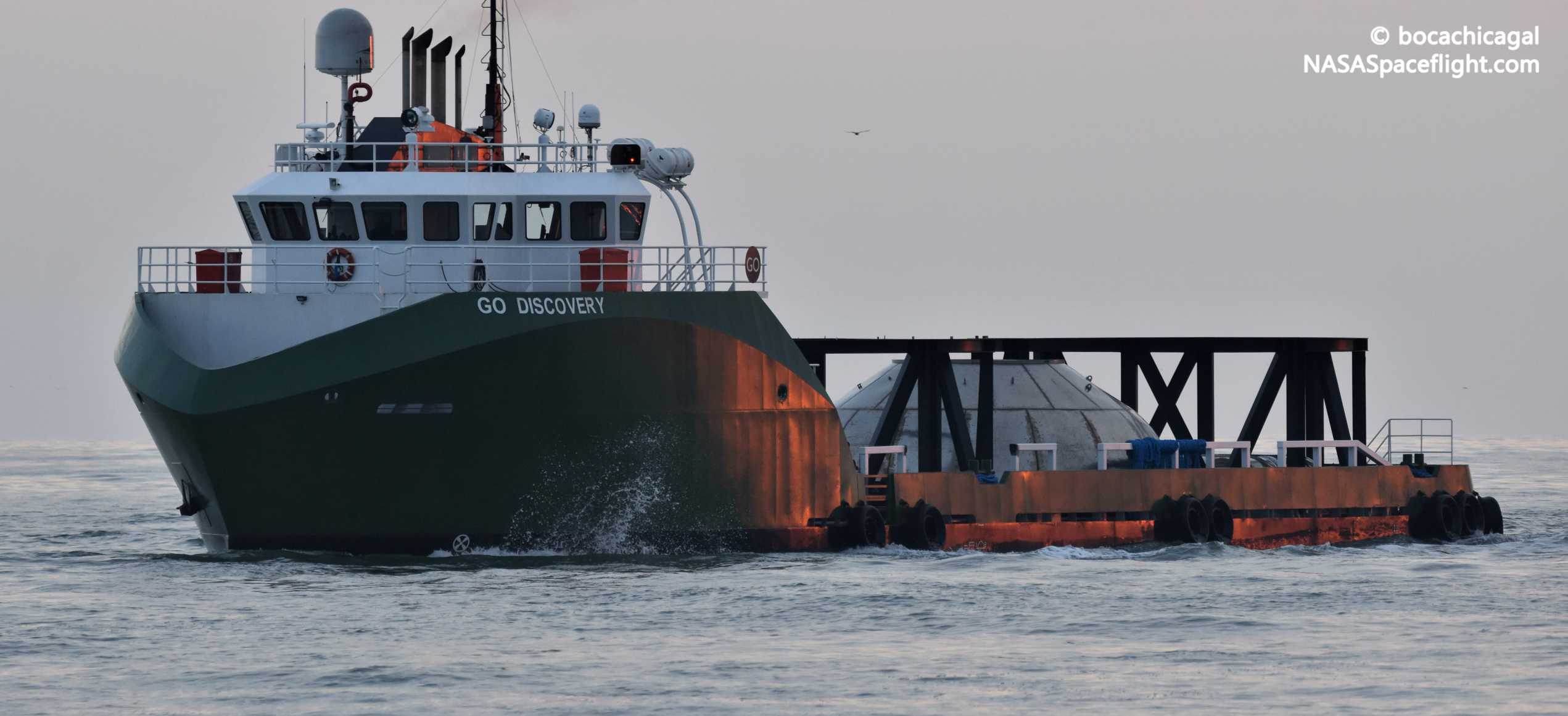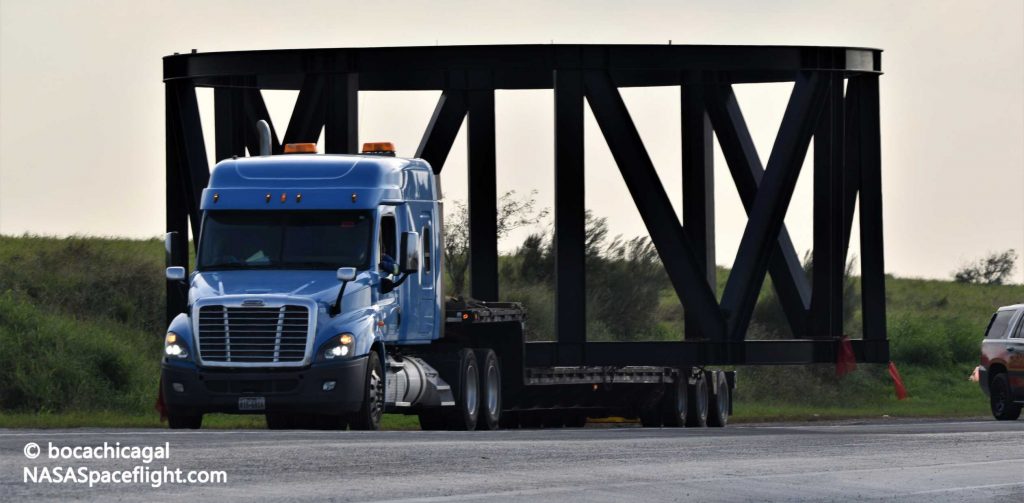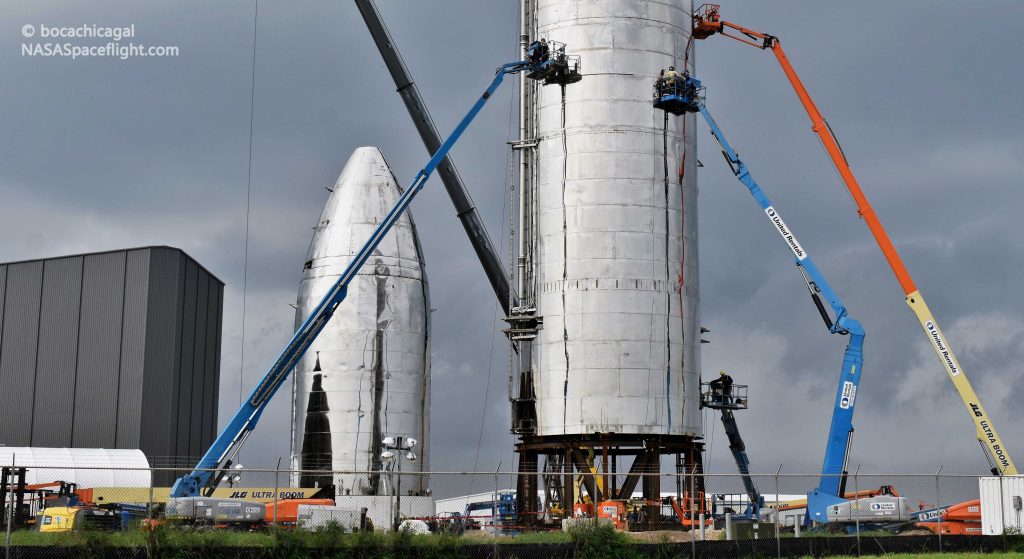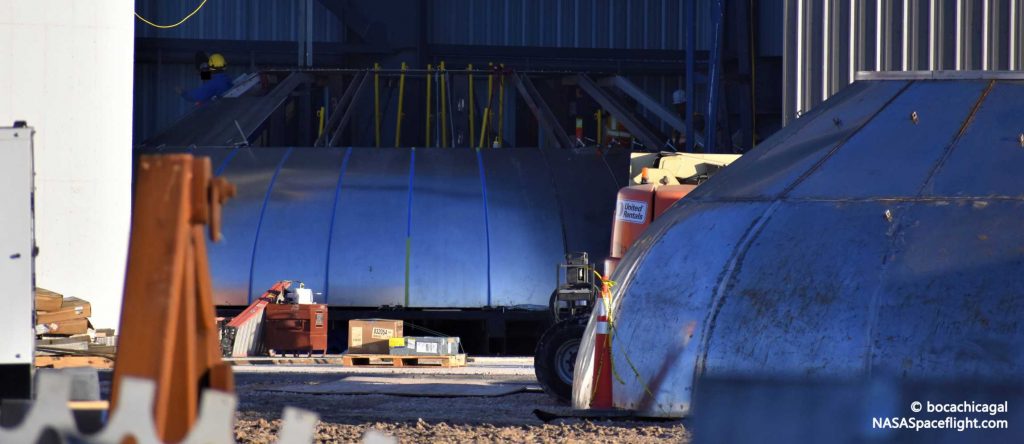

News
SpaceX ships Starship hardware from Florida to Texas to speed up production
After appearing unexpectedly at SpaceX’s Port Canaveral docks last month, several large pieces of Starship flight and manufacturing hardware were successfully shipped from Florida to Texas, arriving at the company’s Boca Chica build and launch site two weeks ago.
Previously discussed on Teslarati, the hardware transfer signals a significant shift in the development strategy for SpaceX’s next-generation Starship-Super Heavy launch vehicle. Most notably, SpaceX has chosen to prioritize Texas in the near term while the company’s Florida facilities instead aim for longer-tail milestones like the first Super Heavy-capable launch site and a new production facility located much closer to that launch site.
While the hardware SpaceX has sent over is relatively minor in the scope of producing a brand new Starship prototype, it will at least somewhat expedite the process thanks to the inclusion of what appears to be a completed propellant tank dome. Additionally, it’s possible that this December 8th hardware delivery will not be the last – a large amount of hardware remains at SpaceX’s Cocoa, Florida Starship production facility, including several ring sections and a nearly finished nose section, among a number of other parts.
As discussed last month, SpaceX has reportedly decided to more or less shutter its Cocoa facilities, transferring all permanent employees who wished to stay to Boca Chica, TX, Cape Canaveral, FL, or Hawthorne, CA facilities. SpaceX’s Starship presence in Florida is in no way done but it does sound like it’s in for at least several months of downtime.
“According to former Cocoa employee that spoke to reporter and channel creator Felix Schlang, SpaceX has reportedly transferred up to 80% of the Starship facility’s workforce to other groups in Florida and Texas. Instead of the friendly internal competition that pitted Cocoa against Boca Chica in the race to first Starship flight, SpaceX is temporarily slowing down its Florida build operations and will redirect as much of its workforce and resources as possible to Boca Chica.
Schlang’s source says that this will likely result in several months of relative downtime in Florida, while he was also told that Starship Mk2 and Mk4 are now effectively dead before arrival as a result of several challenging and reoccurring technical issues. Starship Mk2 likely shares some significant heritage with Starship Mk1, which lost its top during a pressure test. Roughly two-dozen steel Starship Mk4 rings may also be scrapped after SpaceX’s Florida team could not overcome a technical hurdle. Per the source, many of those single-weld steel rings were slightly different diameters, making it next to impossible to build a sound pressure vessel (i.e. Starship Mk4) with them.”
Teslarati.com — December 2nd, 2019
In line with that, SpaceX loaded transport ship GO Discovery with two large steel mounts and a finished tank dome originally believed to be intended for Starship Mk4 and Florida Starship production in general. Those parts arrived in Texas around five days later on December 8th and were rapidly moved from Port of Brownsville to SpaceX’s Boca Chica production facilities.
The ring-like steel structures will likely take the place of (or complement) the concrete structures SpaceX used to mount and assembly Starship Mk1. Likely significantly lighter, steel ring mounts allow far easier access underneath for technicians and engineers while also being much easier to transport in the event that SpaceX wants to reorganize its Starship ‘factory’.


Since arriving at the Boca Chica build site, SpaceX stored the assembly rings off to the side while the Starship Mk3 tank dome (i.e. bulkhead) was situated more centrally. So much is going on at SpaceX’s Boca Chica facilities that it’s no longer easy to determine what is being worked on just from observing, but it’s clear that the employees are working around the clock to prepare for Starship Mk3 assembly.

One or two new tank domes in various states of production are visible, contractors are constructing a warehouse-sized sprung structure (i.e. tent), and technicians are working to refine improved methods of forming the cylindrical steel rings that make up most of Starship. It can’t yet be said that Starship Mk3 has truly begun to take shape, but it’s clear that the goal is to ensure that the process is dramatically faster than it was with Starship Mk1, which took at least half a year to go from first ring stacking to pressure testing.
It’s safe to say that 2020 is going to be an incredibly busy and productive time for SpaceX’s next-generation rocket.
Check out Teslarati’s Marketplace! We offer Tesla accessories, including for the Tesla Cybertruck and Tesla Model 3.

News
Tesla (TSLA) receives “Buy” rating and $551 PT from Canaccord Genuity
He also maintained a “Buy” rating for TSLA stock over the company’s improving long-term outlook, which is driven by autonomy and robotics.

Canaccord Genuity analyst George Gianarikas raised his Tesla (NASDAQ:TSLA) price target from $482 to $551. He also maintained a “Buy” rating for TSLA stock over the company’s improving long-term outlook, which is driven by autonomy and robotics.
The analyst’s updated note
Gianarikas lowered his 4Q25 delivery estimates but pointed to several positive factors in the Tesla story. He noted that EV adoption in emerging markets is gaining pace, and progress in FSD and the Robotaxi rollout in 2026 represent major upside drivers. Further progress in the Optimus program next year could also add more momentum for the electric vehicle maker.
“Overall, yes, 4Q25 delivery expectations are being revised lower. However, the reset in the US EV market is laying the groundwork for a more durable and attractive long-term demand environment.
“At the same time, EV penetration in emerging markets is accelerating, reinforcing Tesla’s potential multi‑year growth runway beyond the US. Global progress in FSD and the anticipated rollout of a larger robotaxi fleet in 2026 are increasingly important components of the Tesla equity story and could provide sentiment tailwinds,” the analyst wrote.
Tesla’s busy 2026
The upcoming year would be a busy one for Tesla, considering the company’s plans and targets. The autonomous two-seat Cybercab has been confirmed to start production sometime in Q2 2026, as per Elon Musk during the 2025 Annual Shareholder Meeting.
Apart from this, Tesla is also expected to unveil the next-generation Roadster on April 1, 2026. Tesla is also expected to start high-volume production of the Tesla Semi in Nevada next year.
Apart from vehicle launches, Tesla has expressed its intentions to significantly ramp the rollout of FSD to several regions worldwide, such as Europe. Plans are also underway to launch more Robotaxi networks in several more key areas across the United States.
News
Waymo sues Santa Monica over order to halt overnight charging sessions
In its complaint, Waymo argued that its self-driving cars’ operations do not constitute a public nuisance, and compliance with the city’s order would cause the company irreparable harm.

Waymo has filed a lawsuit against the City of Santa Monica in Los Angeles County Superior Court, seeking to block an order that requires the company to cease overnight charging at two facilities.
In its complaint, Waymo argued that its self-driving cars’ operations do not constitute a public nuisance, and compliance with the city’s order would cause the company irreparable harm.
Nuisance claims
As noted in a report from the Los Angeles Times, Waymo’s two charging sites at Euclid Street and Broadway have operated for about a year, supporting the company’s growing fleet with round-the-clock activity. Unfortunately, this has also resulted in residents in the area reportedly being unable to sleep due to incessant beeping from self-driving taxis that are moving in and out of the charging stations around the clock.
Frustrated residents have protested against the Waymos by blocking the vehicles’ paths, placing cones, and “stacking” cars to create backups. This has also resulted in multiple calls to the police.
Last month, the city issued an order to Waymo and its charging partner, Voltera, to cease overnight operations at the charging locations, stating that the self-driving vehicles’ activities at night were a public nuisance. A December 15 meeting yielded no agreement on mitigations like software rerouting. Waymo proposed changes, but the city reportedly insisted that nothing would satisfy the irate residents.
“We are disappointed that the City has chosen an adversarial path over a collaborative one. The City’s position has been to insist that no actions taken or proposed by Waymo would satisfy the complaining neighbors and therefore must be deemed insufficient,” a Waymo spokesperson stated.
Waymo pushes back
In its legal complaint, Waymo stated that its “activities at the Broadway Facilities do not constitute a public nuisance.” The company also noted that it “faces imminent and irreparable harm to its operations, employees, and customers” from the city’s order. The suit also stated that the city was fully aware that the Voltera charging sites would be operating around the clock to support Waymo’s self-driving taxis.
The company highlighted over one million trips in Santa Monica since launch, with more than 50,000 rides starting or ending there in November alone. Waymo also criticized the city for adopting a contentious strategy against businesses.
“The City of Santa Monica’s recent actions are inconsistent with its stated goal of attracting investment. At a time when the City faces a serious fiscal crisis, officials are choosing to obstruct properly permitted investment rather than fostering a ‘ready for business’ environment,” Waymo stated.
News
Tesla FSD v14.2.2 is getting rave reviews from drivers
So far, early testers have reported buttery-smooth drives with confident performance, even at night or on twisty roads.

Tesla Full Self-Driving (Supervised) v14.2.2 is receiving positive reviews from owners, with several drivers praising the build’s lack of hesitation during lane changes and its smoother decision-making, among others.
The update, which started rolling out on Monday, also adds features like dynamic arrival pin adjustment. So far, early testers have reported buttery-smooth drives with confident performance, even at night or on twisty roads.
Owners highlight major improvements
Longtime Tesla owner and FSD user @BLKMDL3 shared a detailed 10-hour impression of FSD v14.2.2, noting that the system exhibited “zero lane change hesitation” and “extremely refined” lane choices. He praised Mad Max mode’s performance, stellar parking in locations including ticket dispensers, and impressive canyon runs even in dark conditions.
Fellow FSD user Dan Burkland reported an hour of FSD v14.2.2’s nighttime driving with “zero hesitations” and “buttery smooth” confidence reminiscent of Robotaxi rides in areas such as Austin, Texas. Veteran FSD user Whole Mars Catalog also demonstrated voice navigation via Grok, while Tesla owner Devin Olsen completed a nearly two-hour drive with FSD v14.2.2 in heavy traffic and rain with strong performance.
Closer to unsupervised
FSD has been receiving rave reviews, even from Tesla’s competitors. Xpeng CEO He Xiaopeng, for one, offered fresh praise for FSD v14.2 after visiting Silicon Valley. Following extended test drives of Tesla vehicles running the latest FSD software, He stated that the system has made major strides, reinforcing his view that Tesla’s approach to autonomy is indeed the proper path towards autonomy.
According to He, Tesla’s FSD has evolved from a smooth Level 2 advanced driver assistance system into what he described as a “near-Level 4” experience in terms of capabilities. While acknowledging that areas of improvement are still present, the Xpeng CEO stated that FSD’s current iteration significantly surpasses last year’s capabilities. He also reiterated his belief that Tesla’s strategy of using the same autonomous software and hardware architecture across private vehicles and robotaxis is the right long-term approach, as it would allow users to bypass intermediate autonomy stages and move closer to Level 4 functionality.








